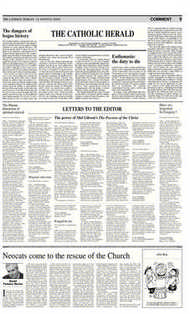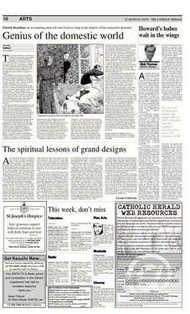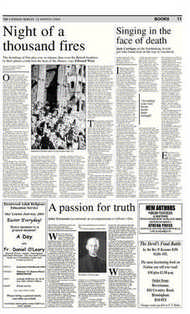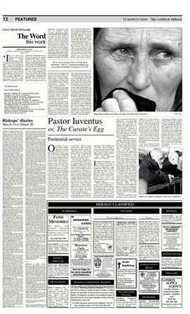Page 7, 12th March 2004
Page 7
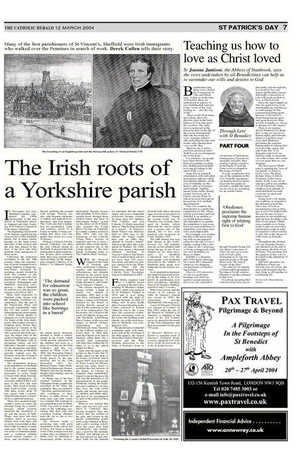
Report an error
Noticed an error on this page?If you've noticed an error in this article please click here to report it.
Tags
Share
Related articles
Vincentian Priests: A Clarification
Rev. N. Comerford, C.m.
Rev. Bernard Ford
50,800 Religious Will Celebrate
They'll Know What To Do About 'albemarle'
Celebrations To Mark Saint's Birth
The Irish roots of a Yorkshire parish
In November last year, Sheffield Catholics celebrated the 150th Anniversary of the first arrival of Vincentian priests to England and their founding of St Vincent’s Church in Solly Street, Sheffield.
The beginnings and growth of St Vincent’s parish tell the story not just of this Sheffield parish, but of many similar parishes in the main towns and cities of this country, and the part they played in the lives of the poor and often destitute Irish immigrants of those years.
Following the industrial revolution in the late 18th century, when the manufacture of goods changed from a cottage industry to being factory-based, powered by machines, people flooded in from the country to the towns, looking for work. The population of cities such as Liverpool, Birmingham and Sheffield increased enormously — that of Sheffield by tenfold over the previous century to 80,000 in 1851.
Mass Irish migration to England really began with the changing economic circumstances after the end of the Napoleonic Wars, and increased substantially when the oat and potato crops failed during the great famine of 1845, forcing people to emigrate to avoid starvation. For many of the Irish immigrants, this country was just a stopping place before they emigrated to Canada or the United States, but for those who could not afford the passage, the major cities of the north of England were a great attraction. Sheffield, with its prospering cutlery and tool industries, became a magnet for the immigrants and many of those arriving in Sheffield actually walked over the Pennines from the Liverpool Docks, where they had disembarked.
The tremendous increase in the population of Sheffield led to the central township, consisting of small farming enclosures or crofts, being covered with cheap housing. The Irish immigrants, by necessity, settled in the Crofts next to the iron and steel works. They lived in houses built back-to-back, usually with three rooms about 10 feet square with a parlour, bedroom and garret, connected by a cupboard staircase.
These were packed closely around a series of courts, the entrance being by a narrow passage, which severely restricted the circulation of air and the access of light. Wages were poor and most families lived in poverty. Homes were very basic and severely overcrowded as they had to take in lodgers to make ends meet. The water supply was from a communal pump, and a common midden served twenty families or more, and invariably over flowed, polluting the ground with sewage. Disease was rife, with frequent outbreaks of typhus and typhoid fever, dysentery, and even plague. The Crofts also had a reputation for prostitution, crime and violence, much of it based on drink, it being estimated that there was one public beer house for every 20 houses.
St Marie’s Church, now the present Cathedral, was then the only Catholic church in Sheffield. It attracted the Irish immigrants in their hundreds, but despite their common faith, they were greeted with open hostility by the indigenous English Catholics of St Marie’s. Fr Edmund Scully, the parish priest, therefore decided to build a schoolchapel in the Crofts, which would provide education for the children and serve as a place of worship for the Irish Catholics, and this was opened at White Croft in 1853. The Vincentian Fathers in Dublin had promised Fr Scully priests for the new mission, and on the 13th November 1853, Frs. Michael Burke, James Kelly, Patrick Kickham and Thomas Plunkett, and one lay-brother, Brother John Bradley, arrived in Sheffield.
Fr Burke, one of the four original founders of the Vincentian Order, graphically described in his diary the conditions they encountered. “The dirty, squalid and miserable conditions of their homes, or rather hovels, in back lanes and dark courts (we counted 100 residents in one small dark court in White Croft) was such as made us come to the saddening conclusion that their pale and wretched looking children must die out in one or two generations”.
The mission made a promising start, with good attendances at the school and at Mass, but failed to attract some of the younger men and women who, according to Fr Burke, had “no difficulty in frequenting public houses, particularly dancing houses and returning at most unreasonable hours through those wicked streets and lanes to their parents’ homes”. Acting on the advice of Dr O’Brien, who founded the Young Men’s Society in Limerick, he formed a similar society in May 1854. This was the beginning of the Catholic Young Men’s Society in England, and was to have a dramatic effect on the spiritual and temporal life of the young people of the new parish, continuing today as The Catholic Men’s Society.
With the financial support of the Duke of Norfolk and other prominent Catholics, together with parishioners’ subscriptions and stipends donated by the priests from missions given as far afield as York and Manchester, Fr Burke decided to start building St Vincent’s Church.
The church designed by George Goldie, a pupil of Pugin, was opened in December 1856 and at the first Mass celebrated by Fr Burke, a statue of St Vincent, donated by the Sisters of Charity, literally arrived in time for the ceremony to the joy of the congregation. The missioners also cared for the needs of Catholics living outside Sheffield, establishing Mass Centres at the recusant chapel at Revell Grange, Stannington, and at Hillsborough Army Barracks for the Catholic soldiers stationed there. In 1860, they built the Church of St.Ann at Deepcar, where there was a sizeable Irish community who had often walked the 10 miles or so to the school chapel for Mass.
Such were the needs of the people in the Crofts that Fr Burke asked for the help of the Sisters of Charity, and in August 1857, four Sisters led by Sister Louise De Missey, moved into Solly Street to establish the first mission of the Sisters of Charity in England. They immediately began to care for the poor, the sick and the homeless of all denominations in the neighbourhood, visiting the hospitals and workhouses. At first, they were met with verbal insults and missile throwing by children and adults alike, and had to be accompanied by men of the parish for their protection.
When it was realised that their care was not just confined to Catholics, they became accepted. They also looked after the welfare of the girls and women in the parish, establishing guilds such as the Children of Mary, and a girl’s evening school. Over the years they built reformatories and orphanages, cared for the mentally retarded, and opened one of the first schools for deaf children. Such was the demand for education, that the school chapel and even a makeshift classroom became overrun by more than 300 children, both Catholic and non Catholic. Fr Burke described them as “like herrings packed in a barrel”. St Vincent’s Infant School was therefore built in 1863 next to the church. The Sisters taught here and, in 1889, they opened St Joseph’s Infants’ School at the other side of the parish in Walkley. By 1896, there were nearly a thousand children attending St Vincent’s School. The Sisters were to teach in these schools for more than 100 years. Secondary education for girls was catered for by the Notre Dame Nuns, and the Vincentians opened the first Catholic Boys’ Secondary School in Sheffield in 1878.
Fr Burke acquired land for a Catholic burial ground at Rivelin Glen, building St Michael’s chapel in 1863, which was replaced by St Michael’s Church in 1878 and is now being restored with the help of English Heritage. In 1864, Fr Burke, now in poor health after 10 years labouring in the Crofts, returned to Ireland where he was to die a year later. His successors continued his missionary work in the Crofts; the building of the church, one of the most beautiful in Sheffield, was completed in 1911.
The parish had a wonderful communal spirit, with traditions such as the crowning of the May Queen, the Sacred Heart and Corpus Christi processions and the Whit Monday procession to the Duke of Norfolk’s home in Norfolk Park; these attracted large crowds of spectators of all denominations. During the second world war, St Vincent’s was severely damaged by bombs, which destroyed the school chapel and a greater part of the church, but it was soon repaired and reopened on Easter Sunday, 1942.
The 20th century saw very little change in the Crofts. Poverty was still endemic and one in four children died before the age of one. It was singled out for slum clear ance by Sheffield Corporation and over the years people were gradually rehoused in the suburbs of Sheffield their needs now being met by the welfare services.
As its population declined, the church found itself isolated on the fringe of its own parish; its parishioners, now more prosperous, attending Mass at St Joseph’s, Walkley, and Our Lady’s, Crookes.
With fewer priests and the closure of its schools in 1989, St Vincent’s Church was closed in 1996, the Vincentians leaving Sheffield the following year.
A new St Vincent’s Church was opened in Crookes in May 2001, under the care of the Diocese of Hallam so St Vincent’s is adapting to the needs of the 21st Century just as it catered for the needs of the Irish immigrants and their descendants for the past 150 years.
blog comments powered by Disqus










